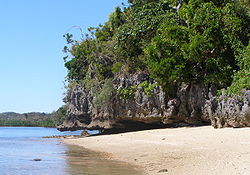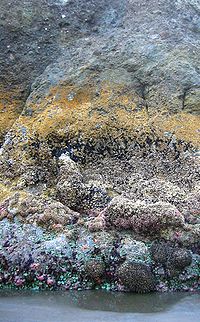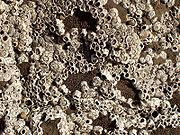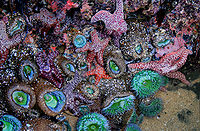
Intertidal ecology
Encyclopedia

Intertidal zone
The intertidal zone is the area that is above water at low tide and under water at high tide . This area can include many different types of habitats, with many types of animals like starfish, sea urchins, and some species of coral...
ecosystem
Ecosystem
An ecosystem is a biological environment consisting of all the organisms living in a particular area, as well as all the nonliving , physical components of the environment with which the organisms interact, such as air, soil, water and sunlight....
s, where organisms live between the low and high tide
Tide
Tides are the rise and fall of sea levels caused by the combined effects of the gravitational forces exerted by the moon and the sun and the rotation of the Earth....
lines. At low tide, the intertidal is exposed whereas at high tide, the intertidal is underwater. Intertidal ecologists therefore study the interactions between intertidal organisms and their environment, as well as between different species
Biological interaction
Biological interactions are the effects organisms in a community have on one another. In the natural world no organism exists in absolute isolation, and thus every organism must interact with the environment and other organisms...
of intertidal organisms within a particular intertidal community. The most important environmental and species interactions may vary based on the type of intertidal community being studied, the broadest of classifications being based on substrates - rocky shore
Rocky shore
A rocky shore is an intertidal area of seacoasts where solid rock predominates. Rocky shores are biologically rich environments, and make the ideal natural laboratory for studying intertidal ecology and other biological processes...
and soft bottom communities.
Organisms living in this zone have a highly variable and often hostile environment, and have evolved various adaptation
Adaptation
An adaptation in biology is a trait with a current functional role in the life history of an organism that is maintained and evolved by means of natural selection. An adaptation refers to both the current state of being adapted and to the dynamic evolutionary process that leads to the adaptation....
s to cope with and even exploit these conditions. One easily visible feature of intertidal communities is vertical zonation, where the community is divided into distinct vertical bands of specific species going up the shore. Species ability to cope with abiotic factors
Abiotic stress
Abiotic stress is defined as the negative impact of non-living factors on the living organisms in a specific environment. The non-living variable must influence the environment beyond its normal range of variation to adversely affect the population performance or individual physiology of the...
associated with emersion stress, such as desiccation
Desiccation
Desiccation is the state of extreme dryness, or the process of extreme drying. A desiccant is a hygroscopic substance that induces or sustains such a state in its local vicinity in a moderately sealed container.-Science:...
determines their upper limits, while biotic
Biotic component
Biotic components are the living things that shape an ecosystem. A biotic factor is any living component that affects another organism, including animals that consume the organism in question, and the living food that the organism consumes. Each biotic factor needs energy to do work and food for...
interactions e.g.competition
Competition (biology)
Competition is an interaction between organisms or species, in which the fitness of one is lowered by the presence of another. Limited supply of at least one resource used by both is required. Competition both within and between species is an important topic in ecology, especially community ecology...
with other species sets their lower limits.
Intertidal regions are utilized
Exploitation of natural resources
Main article: OverexploitationSome exploitation of natural resources is an essential condition of the human existence. This refers primarily to food production and necessities...
by humans for food and recreation, but anthropogenic actions also have major impacts, with overexploitation
Overexploitation
Overexploitation, also called overharvesting, refers to harvesting a renewable resource to the point of diminishing returns. Sustained overexploitation can lead to the destruction of the resource...
, invasive species
Invasive species
"Invasive species", or invasive exotics, is a nomenclature term and categorization phrase used for flora and fauna, and for specific restoration-preservation processes in native habitats, with several definitions....
and climate change
Global warming
Global warming refers to the rising average temperature of Earth's atmosphere and oceans and its projected continuation. In the last 100 years, Earth's average surface temperature increased by about with about two thirds of the increase occurring over just the last three decades...
being among the problems faced by intertidal communities. In some places Marine Protected Area
Marine Protected Area
Marine Protected Areas, like any protected area, are regions in which human activity has been placed under some restrictions in the interest of conserving the natural environment, it's surrounding waters and the occupant ecosystems, and any cultural or historical resources that may require...
s have been established to protect these areas and aid in scientific research.
Types of intertidal communities
Intertidal habitats can be characterized as having either hard or soft bottoms substrates. Rocky intertidal communities occur on rocky shores, such as headlandHeadland
A headland is a point of land, usually high and often with a sheer drop, that extends out into a body of water.Headland can also refer to:*Headlands and bays*headLand, an Australian television series...
s, cobble beach
Beach
A beach is a geological landform along the shoreline of an ocean, sea, lake or river. It usually consists of loose particles which are often composed of rock, such as sand, gravel, shingle, pebbles or cobblestones...
es, or human-made jetties
Jetty
A jetty is any of a variety of structures used in river, dock, and maritime works that are generally carried out in pairs from river banks, or in continuation of river channels at their outlets into deep water; or out into docks, and outside their entrances; or for forming basins along the...
. Their degree of exposure may be calculated using the Ballantine Scale
Ballantine Scale
The Ballantine Scale is a biologically defined scale for measuring the degree of exposure level of wave action on a rocky shore. Devised in 1961 by W. J...
. Soft-sediment habitats include sandy beach
Beach
A beach is a geological landform along the shoreline of an ocean, sea, lake or river. It usually consists of loose particles which are often composed of rock, such as sand, gravel, shingle, pebbles or cobblestones...
es, and intertidal wetland
Intertidal wetland
An intertidal wetland is a the area along a shoreline that is exposed to air at low tide and submerged at high tide. This type of wetland is defined by an intertidal zone and includes its own intertidal ecosystems.-Description:...
s (e.g., mudflat
Mudflat
Mudflats or mud flats, also known as tidal flats, are coastal wetlands that form when mud is deposited by tides or rivers. They are found in sheltered areas such as bays, bayous, lagoons, and estuaries. Mudflats may be viewed geologically as exposed layers of bay mud, resulting from deposition of...
s, and salt marshes). These habitats differ in levels of abiotic, or non-living, environmental factors. Rocky shores tend to have higher wave action, requiring adaptations allowing the inhabitants to cling tightly to the rocks. Soft-bottom habitats are generally protected from large waves but tend to have more variable salinity
Salinity
Salinity is the saltiness or dissolved salt content of a body of water. It is a general term used to describe the levels of different salts such as sodium chloride, magnesium and calcium sulfates, and bicarbonates...
levels. They also offer a third habitable dimension—depth—thus, many soft-sediment inhabitants are adapted for burrowing.
Environment

Intertidal organisms, especially those in the high intertidal, must cope with a large range of temperatures. While they are underwater, temperatures may only vary by a few degrees over the year. However, at low tide, temperatures may dip to below freezing or may become scaldingly hot, leading to a temperature range that may approach 30 °C (86 °F) during a period of a few hours. Many mobile organisms, such as snails and crabs, avoid temperature fluctuations by crawling around and searching for food at high tide and hiding in cool, moist refuges (crevices or burrows) at low tide. Besides simply living at lower tide heights, non-motile organisms may be more dependent on coping mechanisms. For example, high intertidal organisms have a stronger stress response, a physiological response of making proteins that help recovery from temperature stress just as the immune response aids in the recovery from infection.
Intertidal organisms are also especially prone to desiccation
Desiccation
Desiccation is the state of extreme dryness, or the process of extreme drying. A desiccant is a hygroscopic substance that induces or sustains such a state in its local vicinity in a moderately sealed container.-Science:...
during periods of emersion. Again, mobile organisms avoid desiccation in the same way as they avoid extreme temperatures: by hunkering down in mild and moist refuges. Many intertidal organisms, including Littorina snails, prevent water loss by having waterproof outer surfaces, pulling completely into their shells, and sealing shut their shell opening. Limpets (Patella) do not use such a sealing plate but occupy a home-scar to which they seal the lower edge of their flattened conical shell using a grinding action. They return to this home-scar after each grazing excursion, typically just before emersion. On soft rocks, these scars are quite obvious. Still other organisms, such as the algae Ulva and Porphyra, are able to rehydrate and recover after periods of severe desiccation.
The level of salinity
Salinity
Salinity is the saltiness or dissolved salt content of a body of water. It is a general term used to describe the levels of different salts such as sodium chloride, magnesium and calcium sulfates, and bicarbonates...
can also be quite variable. Low salinities can be caused by rainwater or river inputs of freshwater. Estuarine species must be especially euryhaline
Euryhaline
Euryhaline organisms are able to adapt to a wide range of salinities. An example of a euryhaline fish is the molly which can live in fresh, brackish, or salt water. The European shore crab is an example of a euryhaline invertebrate that can live in salt and brackish water...
, or able to tolerate a wide range of salinities. High salinities occur in locations with high evaporation rates, such as in salt marshes and high intertidal pools. Shading by plants, especially in the salt marsh, can slow evaporation and thus ameliorate salinity stress. In addition, salt marsh plants tolerate high salinities by several physiological mechanisms, including excreting salt through salt glands and preventing salt uptake into the roots.
In addition to these exposure stresses (temperature, desiccation, and salinity), intertidal organisms experience strong mechanical stresses, especially in locations of high wave action
Wave
In physics, a wave is a disturbance that travels through space and time, accompanied by the transfer of energy.Waves travel and the wave motion transfers energy from one point to another, often with no permanent displacement of the particles of the medium—that is, with little or no associated mass...
. There are myriad ways in which the organisms prevent dislodgement due to waves. Morphologically, many mollusks (such as limpets and chitons) have low-profile, hydrodynamic shells. Types of substrate attachments include mussels’ tethering byssal threads and glues, sea stars’ thousands of suctioning tube feet, and isopods’ hook-like appendages that help them hold onto intertidal kelps. Higher profile organisms, such as kelps, must also avoid breaking in high flow locations, and they do so with their strength and flexibility. Finally, organisms can also avoid high flow environments, such as by seeking out low flow microhabitats. Additional forms of mechanical stresses include ice and sand scour, as well as dislodgment by water-borne rocks, logs, etc.
For each of these climate stresses, species exist that are adapted to and thrive in the most stressful of locations. For example, the tiny crustacean copepod Tigriopus thrives in very salty, high intertidal tidepools, and many filter feeders find more to eat in wavier and higher flow locations. Adapting to such challenging environments gives these species competitive edges in such locations.
Food web structure

Photosynthesis
Photosynthesis is a chemical process that converts carbon dioxide into organic compounds, especially sugars, using the energy from sunlight. Photosynthesis occurs in plants, algae, and many species of bacteria, but not in archaea. Photosynthetic organisms are called photoautotrophs, since they can...
phytoplankton
Phytoplankton
Phytoplankton are the autotrophic component of the plankton community. The name comes from the Greek words φυτόν , meaning "plant", and πλαγκτός , meaning "wanderer" or "drifter". Most phytoplankton are too small to be individually seen with the unaided eye...
and consumer zooplankton. These plankton
Plankton
Plankton are any drifting organisms that inhabit the pelagic zone of oceans, seas, or bodies of fresh water. That is, plankton are defined by their ecological niche rather than phylogenetic or taxonomic classification...
are eaten by numerous forms of filter feeders—mussels, clams
CLaMS
CLaMS is a modular chemistry transport model system developed at Forschungszentrum Jülich, Germany. CLaMS was first described by McKenna et al. and was expanded into three dimensions by Konopka et al....
, barnacles, sea squirts, and polychaete
Polychaete
The Polychaeta or polychaetes are a class of annelid worms, generally marine. Each body segment has a pair of fleshy protrusions called parapodia that bear many bristles, called chaetae, which are made of chitin. Indeed, polychaetes are sometimes referred to as bristle worms. More than 10,000...
worms—which filter seawater in their search for planktonic food sources. The adjacent ocean is also a primary source of nutrients for autotrophs, photosynthesizing producers ranging in size from microscopic algae
Algae
Algae are a large and diverse group of simple, typically autotrophic organisms, ranging from unicellular to multicellular forms, such as the giant kelps that grow to 65 meters in length. They are photosynthetic like plants, and "simple" because their tissues are not organized into the many...
(e.g. benthic diatoms) to huge kelp
Kelp
Kelps are large seaweeds belonging to the brown algae in the order Laminariales. There are about 30 different genera....
s and other seaweeds. These intertidal producers are eaten by herbivorous grazers, such as limpets that scrape rocks clean of their diatom layer and kelp crabs that creep along blades of the feather boa kelp Egregia eating the tiny leaf-shaped bladelets. Crabs are eaten by Goliath Grouper, which are then eaten by sharks. Higher up the food web
Food web
A food web depicts feeding connections in an ecological community. Ecologists can broadly lump all life forms into one of two categories called trophic levels: 1) the autotrophs, and 2) the heterotrophs...
, predatory
Predation
In ecology, predation describes a biological interaction where a predator feeds on its prey . Predators may or may not kill their prey prior to feeding on them, but the act of predation always results in the death of its prey and the eventual absorption of the prey's tissue through consumption...
consumers—especially voracious starfish—eat other grazers (e.g. snails) and filter feeders (e.g. mussels). Finally, scavenger
Scavenger
Scavenging is both a carnivorous and herbivorous feeding behavior in which individual scavengers search out dead animal and dead plant biomass on which to feed. The eating of carrion from the same species is referred to as cannibalism. Scavengers play an important role in the ecosystem by...
s, including crabs and sand fleas
Amphipoda
Amphipoda is an order of malacostracan crustaceans with no carapace and generally with laterally compressed bodies. The name amphipoda means "different-footed", and refers to the different forms of appendages, unlike isopods, where all the legs are alike. Of the 7,000 species, 5,500 are classified...
, eat dead organic material, including dead producers and consumers.
Species interactions

One dogma of intertidal ecology—supported by such classic studies—is that species’ lower tide height limits are set by species interactions whereas their upper limits are set by climate variables. Classic studies by Robert Paine established that when sea star predators are removed, mussel beds extend to lower tide heights, smothering resident seaweeds. Thus, mussels’ lower limits are set by sea star predation. Conversely, in the presence of sea stars, mussels’ lower limits occur at a tide height at which sea stars are unable to tolerate climate conditions.
Competition, especially for space, is another dominant interaction structuring intertidal communities. Space competition is especially fierce in rocky intertidal habitats, where habitable space is limited compared to soft-sediment habitats in which three-dimensional space is available. As seen with the previous sea star example, mussels are competitively dominant when they are not kept in check by sea star predation. Joseph Connell's research on two types of high intertidal barnacles, a Balanus and a Chthamalus species, showed that zonation patterns could also be set by competition between closely related organisms. In this example, Balanus outcompetes Chthamalus at lower tide heights but is unable to survive at higher tide heights. Thus, Balanus conforms to the intertidal ecology dogma introduced above: its lower tide height limit is set by a predatory snail and its higher tide height limit is set by climate. Similarly, Chthamalus, which occurs in a refuge from competition (similar to the temperature refuges discussed above), has a lower tide height limit set by competition with Balanus and a higher tide height limit is set by climate.

All of the examples given so far are of direct interactions: Species A eat Species B or Species B eats Species C. Also important are indirect interactions where, using the previous example, Species A eats so much of Species B that predation on Species C decreases and Species C increases in number. Thus, Species A indirectly benefits Species C. Pathways of indirect interactions can include all other forms of species interactions. To follow the sea star-mussel relationship, sea stars have an indirect negative effect on the diverse community that lives in the mussel bed because, by preying on mussels and decreasing mussel bed structure, those species that are facilitated by mussels are left homeless.
Additional important species interactions include mutualism, which is seen in symbioses between sea anemones and their internal symbiotic algae, and parasitism
Parasitism
Parasitism is a type of symbiotic relationship between organisms of different species where one organism, the parasite, benefits at the expense of the other, the host. Traditionally parasite referred to organisms with lifestages that needed more than one host . These are now called macroparasites...
, which is prevalent but is only beginning to be appreciated for its effects on community structure.
Current topics
Humans are highly dependent on intertidal habitats for food and raw materials, and over 50% of humans live within 100 km of the coast. Therefore, intertidal habitats are greatly influenced by human impacts to both ocean and land habitats. Some of the conservation issues associated with intertidal habitats and at the head of the agendas of managers and intertidal ecologists are:1. Climate change
Climate change
Climate change is a significant and lasting change in the statistical distribution of weather patterns over periods ranging from decades to millions of years. It may be a change in average weather conditions or the distribution of events around that average...
: Intertidal species are challenged by several of the effects of global climate change, including increased temperatures, sea level rise, and increased storminess. Ultimately, it has been predicted that the distributions and numbers of species will shift depending on their abilities to adapt (quickly!) to these new environmental conditions. Due to the global scale of this issue, scientists are mainly working to understand and predict possible changes to intertidal habitats.
2. Invasive species
Invasive species
"Invasive species", or invasive exotics, is a nomenclature term and categorization phrase used for flora and fauna, and for specific restoration-preservation processes in native habitats, with several definitions....
: Invasive species are especially prevalent in intertidal areas with high volumes of shipping traffic, such as large estuaries, because of the transport of non-native species in ballast
Sailing ballast
Ballast is used in sailboats to provide moment to resist the lateral forces on the sail. Insufficiently ballasted boats will tend to tip, or heel, excessively in high winds. Too much heel may result in the boat capsizing. If a sailing vessel should need to voyage without cargo then ballast of...
water. San Francisco Bay, in which an invasive Spartina cordgrass from the east coast is currently transforming mudflat communities into Spartina meadows, is among the most invaded estuaries in the world. Conservation efforts are focused on trying to eradicate some species (like Spartina) in their non-native habitats as well as preventing further species introductions (e.g. by controlling methods of ballast water uptake and release).
3. Marine protected areas: Many intertidal areas are lightly to heavily exploited by humans for food gathering (e.g. clam digging in soft-sediment habitats and snail, mussel, and algal collecting in rocky intertidal habitats). In some locations, marine protected areas have been established where no collecting is permitted. The benefits of protected areas may spill over to positively impact adjacent unprotected areas. For example, a greater number of larger egg capsules of the edible snail Concholepus in protected vs. non-protected areas in Chile indicates that these protected areas may help replenish snail stocks in areas open to harvesting. The degree to which collecting is regulated by law differs with the species and habitat.
See also
- Intertidal zoneIntertidal zoneThe intertidal zone is the area that is above water at low tide and under water at high tide . This area can include many different types of habitats, with many types of animals like starfish, sea urchins, and some species of coral...
- Littoral zone
- Surf zoneSurf zoneAs ocean surface waves come closer to shore they break, forming the foamy, bubbly surface we call surf. The region of breaking waves defines the surf zone. After breaking in the surf zone, the waves continue to move in, and they run up onto the sloping front of the beach, forming an uprush of...
- Ecological forecastingEcological forecastingEcological forecasting uses knowledge of physics, ecology and physiology to predict how ecosystems will change in the future in response to environmental factors such as climate change...
- NaGISANaGISANaGISA is an international collaborative effort aimed at inventorying, cataloguing, and monitoring biodiversity of the in-shore area. So named for the Japanese word "nagisa" , it is an Apronym...
General
- Bertness MD, SD Gaines, and ME Hay (2001) Marine community ecology. Sinauer Associates, Inc.
- Kozloff EN (1973) Seashore life of the northern Pacific coast. University of Washington Press.
- Ricketts EFEd RickettsEdward Flanders Robb Ricketts commonly known as Ed Ricketts, was an American marine biologist, ecologist, and philosopher...
, J Calvin and JW Hedgpeth (1939) Between Pacific TidesBetween Pacific TidesBetween Pacific Tides is a 1939 book by Ed Ricketts and Jack Calvin that explores the intertidal ecology of the Pacific coast of the United States...
(5th Ed.) Stanford University Press.

